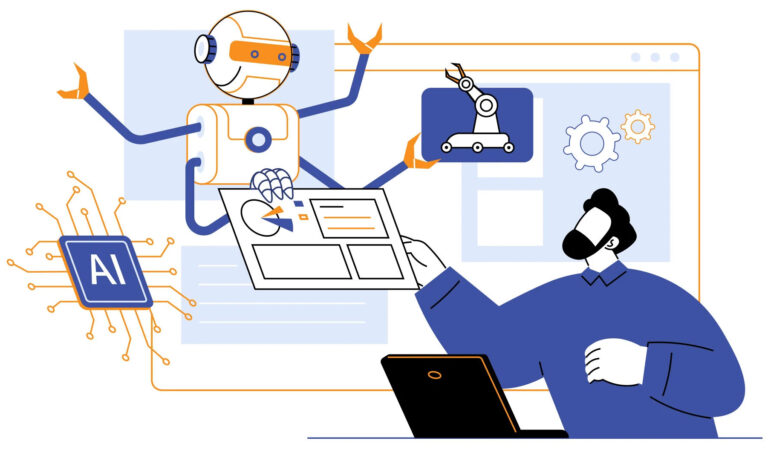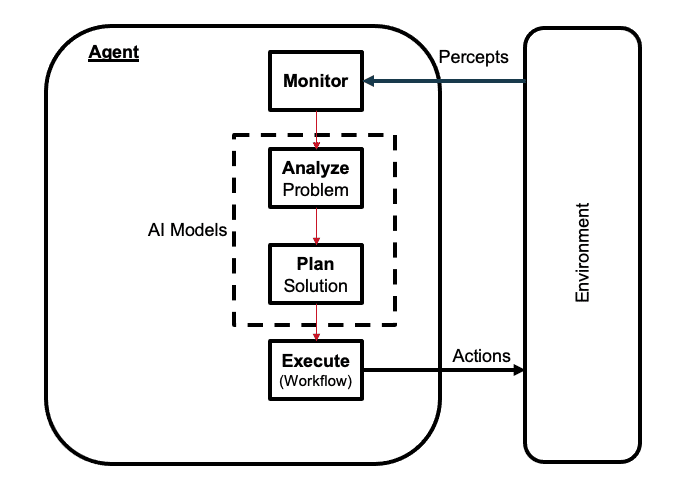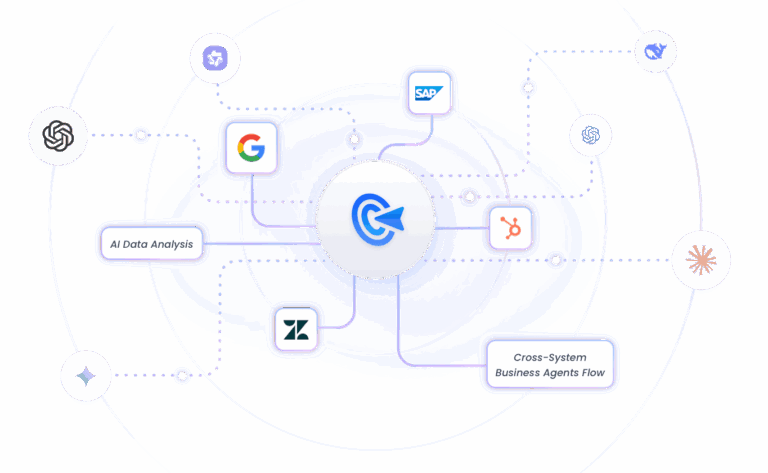AI agentic workflows are transforming work by enabling AI agents to understand goals, make decisions, and adapt in real time. With advances in large language models and automation, AI is evolving from a simple assistant into an autonomous performer managing entire processes.
In this guide, we'll explore everything about AI agent workflows and how the right platform can help you put them into action. So let's get started!
What Are AI Agentic Workflows?

Think of AI agentic workflows as having a smart, reliable teammate who doesn’t just wait for you to tell them every single step—they understand the goal, figure out the best way to get there, and adapt when things change. In an agentic workflow, the AI has “agency,” meaning it can think, choose, and act on its own. It can assess the situation, make a plan, and adjust course if something unexpected happens—much like a skilled colleague who can handle a project from start to finish without constant supervision.
Key Characteristics
● Goal-Oriented Behavior: Agents aim for the end goal rather than blindly following a preset checklist.
● Dynamic Decision-Making: They weigh options, consider trade-offs, and pick best strategy based on the situation.
● Contextual Awareness: They keep track of what’s happened, what’s happening now, and what might happen next.
● Self-Correction: If they make a mistake or conditions change, they adjust and keep moving forward.
● Multi-Tool Integration: They connect and coordinate multiple tools, platforms, and systems to get the job done.
Traditional Automation vs AI Workflow vs AI Agentic Workflow
Automation has evolved from fixed, rule-based systems to AI-powered workflows, and now to fully agentic workflows. Each stage brings more intelligence and flexibility. Here’s a quick comparison to help you understand the differences.
| Features | Traditional Automation | AI Workflow | AI Agentic Workflow |
|---|---|---|---|
| How It Works | Follows a fixed, pre-written script | Uses AI for specific steps, but still in a set order | AI plans, executes, and adapts the entire process |
| Flexibility | Low – breaks if something changes | Medium – can adjust within certain limits | High – can rethink the plan when conditions shift |
| Decision-Making | None – only does what it’s told | Limited – AI makes choices within predefined rules | Full – AI reasons and chooses the best path |
| Goal Understanding | Task-level only | Task-level with some context | Understands and works toward the overall goal |
| Error Handling | Needs human intervention | Can fix some issues | Self-corrects and keeps going |
| Tool Use | Predefined tools only | AI can use some tools | AI can pick and combine the right tools on the fly |
Traditional automation is like a factory machine—it’s fast, but only if nothing changes. AI workflows add some “smarts,” helping with certain tasks, but they still rely on a set plan. AI agentic workflows are more like a skilled project manager: they understand the goal, figure out the best route, and adapt along the way, handling surprises without needing you to jump in every time.
Benefits of AI Agentic Workflows
AI agentic workflows represent a major leap forward in automation technology. By empowering AI agents to independently plan, reason, and adapt, these workflows overcome many limitations of traditional scripted automation. This leads to significant improvements in how businesses and individuals handle complex, dynamic tasks. The core benefits include:
● Enhanced Efficiency: Agentic workflows reduce the need for constant human intervention by autonomously managing multi-step processes. This frees teams to focus on higher-value activities and accelerates task completion.
● Dynamic Adaptability: Unlike rigid automation, these workflows can detect changes or errors in real-time and adjust their strategies accordingly. This self-correcting ability improves overall reliability and reduces downtime.
● Intelligent Integration: AI agents coordinate multiple tools, APIs, and data sources seamlessly, allowing for sophisticated reasoning and comprehensive solutions that single tools alone cannot achieve.
● Cost Reduction and Agility: Automating complex tasks that usually require expert human input cuts operational costs and enables faster scaling. Businesses gain the agility to respond quickly to evolving market demands and challenges.
● Improved Accuracy and Quality: Continuous evaluation and adjustment throughout the workflow ensure higher-quality outcomes with fewer mistakes or oversights.
How Do AI Agentic Workflows Work?

AI agentic workflows begin with a user’s high-level goal, such as “launch a new marketing campaign” or “compile last quarter’s sales report.” Unlike traditional automation that needs step-by-step instructions, the AI interprets this goal and autonomously breaks it down into smaller, actionable tasks. For example, it might identify tasks like designing creative assets, scheduling social media posts, and sending update emails.
Next, the AI develops a plan to tackle these tasks efficiently, deciding which ones to do first and which can run in parallel. It then interacts with various tools and platforms to carry out the work — maybe generating content with a writing tool, pulling data from a CRM, or coordinating calendars.
As the workflow progresses, the AI continuously monitors results and environmental changes. Suppose a deadline shifts or a resource becomes unavailable—the AI dynamically adjusts the plan, reprioritizing tasks or seeking alternatives to keep things on track. Once all tasks are complete, it can generate a summary report or notify stakeholders automatically.
Key Components of an AI Agentic Workflow
To enable this complex orchestration, AI agentic workflows rely on several essential components working in harmony:
1. AI Agent (The Brain)
Powered by advanced models like GPT, the AI agent interprets goals, reasons through problems, and makes decisions. It acts as the central thinker guiding the workflow.
2. Planner & Task Manager
This component breaks down high-level goals into smaller tasks, sequences them logically, and manages execution priorities to optimize efficiency.
3. Memory & Context Manager
Keeps track of prior actions, relevant data, and ongoing context so the AI maintains continuity and makes decisions based on up-to-date information.
4. Tool Integrations & API Connectors
These interfaces allow the AI to connect and communicate with external applications—such as email systems, databases, analytics platforms, or messaging apps—extending its capabilities beyond text processing.
5. Execution Engine
The “hands and feet” of the workflow, responsible for performing actions like sending emails, updating records, or triggering scripts across different systems.
6. Feedback & Monitoring System
Oversees progress, detects errors or unexpected issues, and signals the planner to adjust the workflow as necessary, ensuring resilience and adaptability.
Together, these components create a system where AI doesn’t just follow orders but actively manages and executes complex projects, responding intelligently to changes and minimizing the need for human intervention.
AI Agentic Workflow Use Cases
In agentic workflows, a “use case” isn’t just an industry label—it’s a specific way of combining an AI’s skills like planning, reasoning, and tool use to solve a repeatable type of problem. These setups can vary in autonomy, tool choice, and human involvement, but each follows a clear pattern.
Here are four examples that show agentic workflows in action.
Agentic RAG
Instead of simply fetching documents, agentic RAG breaks complex questions into smaller sub-queries, retrieves and filters results, and reformulates searches when needed. For example, a legal AI might cross-check multiple sources, discard weak evidence, and ask clarifying questions before delivering a concise, verified answer.
Agentic Research Assistant
Given a broad topic—say, “emerging battery tech for aviation”—an agentic research assistant plans the investigation, gathers data from news, patents, and papers, pivots when spotting new leads, and compiles a structured, source-backed report. It adapts mid-search, much like a human researcher who follows promising threads.
Agentic Coding Assistant
Beyond suggesting snippets, an agentic coding assistant can take a feature request, map out changes, write and test code, resolve conflicts, and commit a pull request with documentation updates—handling the full cycle without step-by-step human oversight.
Agentic Content & Marketing Automation
Given a goal like “boost LinkedIn engagement by 30%,” the agent designs a content calendar, posts updates, tracks performance, and adjusts tone or format based on results. If something goes viral, it can instantly spin off a follow-up campaign.
These examples show that “use case” in the agentic AI world is defined less by the industry and more by how the workflow is built—how agents plan, adapt, and integrate tools to achieve goals dynamically.
Experience AI Agentic Workflows with GoInsight.AI
After exploring what AI agentic workflows can do, the next challenge is putting them into practice. Building such workflows from scratch can be complex and resource-intensive. That’s why platforms like GoInsight.AI have emerged—to simplify the process and let you focus on what matters most: delivering value.

With GoInsight AI, you get:
- Dynamic Planning & Multi-Tool Integration: Coordinate multiple AI agents and external tools in one workflow.
- Built-in Retrieval-Augmented Generation (RAG): Enhance AI reasoning with up-to-date data from external sources.
- Low-Code Visual Workflow Builder: Easily design, customize, and manage complex workflows without heavy coding.
- Adaptive Execution & Self-Correction: Workflows automatically adjust to changing conditions and errors.
These features make GoInsight AI ideal for advanced use cases like deep research, content automation, data analytics, and more—helping teams unlock AI’s full potential without starting from zero.
Whether you’re a developer, analyst, or business leader, GoInsight AI empowers you to build intelligent, autonomous workflows that deliver real results—fast and efficiently.
Conclusion
AI agentic workflows represent a transformative leap in how we automate complex tasks—shifting from rigid scripts to adaptable, goal-driven processes. By empowering AI agents to plan, decide, and self-correct, businesses and individuals can tackle challenges with greater efficiency and flexibility.
As this technology matures, platforms like GoInsight AI make it easier than ever to harness these capabilities, enabling you to build intelligent workflows that truly work for you.





Leave a Reply.